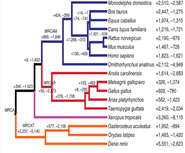The gene order on the X chromosome of eutherians is generally highly conserved, although an increase in the rate of rearrangement has been reported in the rodent lineage. Conservation of the X chromosome is thought to be caused by selection related to maintenance of dosage compensation. However, we herein reveal that the cattle (Btau4.0) lineage has experienced a strong increase in the rate of X-chromosome rearrangement, much stronger than that previously reported for rodents. We also show that this increase is not matched by a similar increase on the autosomes and cannot be explained by assembly errors. Furthermore, we compared the difference in two cattle genome assemblies: Btau4.0 and Btau6.0 (Bos taurus UMD3.1). The results showed a discrepancy between Btau4.0 and Btau6.0 cattle assembly version data, and we believe that Btau6.0 cattle assembly version data are not more reliable than Btau4.0.
The gene order on the X chromosome of eutherians is generally highly conserved, although an increase in the rate of rearrangement has been reported in the rodent lineage. Conservation of the X chromosome is thought to be caused by selection related to maintenance of dosage compensation. However, we herein reveal that the cattle (Btau4.0) lineage has exper...
The gene order on the X chromosome of eutherians is generally highly conserved, although an increase in the rate of rearrangement has been reported in the rodent lineage. Conservation of the X chromosome is thought to be caused by selection related to maintenance of dosage compensation. However, we herein reveal that the cattle (Btau4.0) lineage has experienced a strong increase in the rate of X-chromosome rearrangement, much stronger than that previously reported for rodents. We also show that this increase is not matched by a similar increase on the autosomes and cannot be explained by assembly errors. Furthermore, we compared the difference in two cattle genome assemblies: Btau4.0 and Btau6.0 (Bos taurus UMD3.1). The results showed a discrepancy between Btau4.0 and Btau6.0 cattle assembly version data, and we believe that Btau6.0 cattle assembly version data are not more reliable than Btau4.0.



